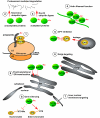Towards a functional understanding of protein N-terminal acetylation
- PMID: 21655309
- PMCID: PMC3104970
- DOI: 10.1371/journal.pbio.1001074
Towards a functional understanding of protein N-terminal acetylation
Abstract
Protein N-terminal acetylation is a major modification of eukaryotic proteins. Its functional implications include regulation of protein-protein interactions and targeting to membranes, as demonstrated by studies of a handful of proteins. Fifty years after its discovery, a potential general function of the N-terminal acetyl group carried by thousands of unique proteins remains enigmatic. However, recent functional data suggest roles for N-terminal acetylation as a degradation signal and as a determining factor for preventing protein targeting to the secretory pathway, thus highlighting N-terminal acetylation as a major determinant for the life and death of proteins. These contributions represent new and intriguing hypotheses that will guide the research in the years to come.
Conflict of interest statement
The author has declared that no competing interests exist.
Figures


References
-
- Brown J. L, Roberts W. K. Evidence that approximately eighty per cent of the soluble proteins from Ehrlich ascites cells are Nalpha-acetylated. J Biol Chem. 1976;251:1009–1014. - PubMed
-
- NARITA K. Isolation of acetylpeptide from enzymic digests of TMV-protein. Biochim Biophys Acta. 1958;28:184–191. - PubMed
-
- Pestana A, Pitot H. C. Acetylation of nascent polypeptide chains on rat liver polyribosomes in vivo and in vitro. Biochemistry. 1975;14:1404–1412. - PubMed
Publication types
MeSH terms
Substances
LinkOut - more resources
Full Text Sources
Other Literature Sources

